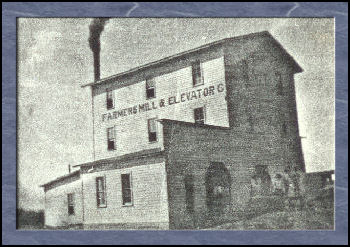
Around 1904-05, J. R. bought into
partnership in the Farmer's Mill in Watonga so they
moved to town and lived on Main Street close to the
mill. Hubert (Bud) was born while they lived
there. |
March 12th was a favorite day of J.
R.'s, on 12 March 1902
he bought he lease on a section of land west of
Watonga that was to become their future home in Blaine
County. While making a trip through western
Oklahoma, he happened to stop at the 'old mule ranch" to
water his team of grey geldings. The fellow
offered to sell his lease on the Indian land he was
leasing and when they got through dealing, the man had
thrown in a disk and a drill with the trade. This
lease was part of the Cheyenne Arapaho Indian
Reservation. The second year they lived in Blaine
County, J. R. bought 160 acres of this lease --
description; S.E. 1/2 of Sec. 7, township 16, range 12
West. This purchase was one of the first two
pieces of land sold in this reservation. This
quarter of land was the government allotment of chief
Red Bird's eldest son, Little Beaver, who was deceased.
(Robert is in possession of the original patent on this
quarter, signed by President Grover Cleveland.) In
later years, this farm became nationally known for the
Shorthorn cattle raised there.
When they first moved to Blaine County in 1902, they
lived in a house on the corner one mile east of the
quarter section that he later bought, I suppose they
leased this land, also. The family all had the
Small Pox that first winter and I remember Nora telling
about how sick they all were, especially Lois who was
just a baby. Lenna was born while they lived
there. |
| In the late
spring of 1907, the year of the "infamous green bug
year", they moved back to the farm that will now be
referred to as the "home place". It had a
small house on it and Hazel was born in this house.
In 1909, they started building around this little
house and made a beautiful, comfortable 9 room, two
story house which was their home for many years.
It was the home these Whisler children, as well as
many of the next generation remember as their
childhood home. This house was completed the
first week of May in 1910 and a few days later
Robert, the last one of their nine children was born
in it. The picture shows the house after it
had been completed a couple of years. |
|
The first Whisler
Shorthorn Sale was held in 1910 with an annual sale
following for several years. This picture
above shows some of the fine breeding stock
advertising in the 1912 sale. J. R. is on the
left and oldest son, Ralph on the right holding this
fine string of purebreds
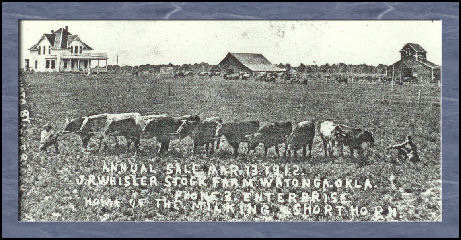
|
In the teen years the
Whisler farms became famous for their Purebred
Shorthorn cattle and was known throughout the middle
west due to the annual sales which were held until
1919 when J. R. had a dispersion sale due to his
declining health. At this sale the cattle
averaged $700 a head with one bull selling for
$5,050 which was a record price in those days.
A trip to Mayo Brothers Clinic soon put J. R. back
on the road to recovery and it wasn't long until he
was back in the business again but not on as large a
scale. He continued in the Shorthorn business
as long as he was on the farm and his sons were all
followers in his footsteps when it came to farming
and good Shorthorn cattle.
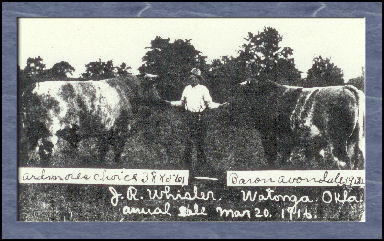
J. R. and two of his
prize bulls. This picture post card advertised
the 1916 sale. The same picture was used in
many of his advertisements in the next few years.
|
Children of J. R. and Nora Whisler
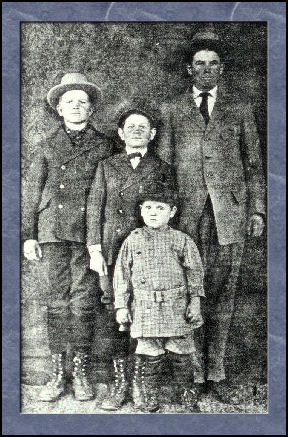 Maburn, Everett, Ralph and Hubert |
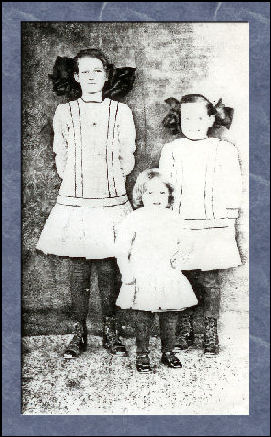 Lois, Lenna and Hazel |
|
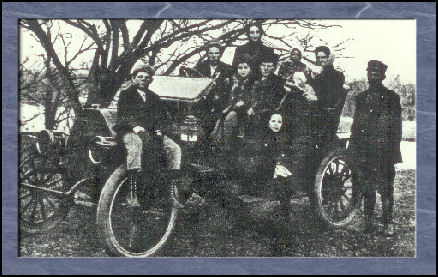
The J.
R. Whisler Family in 1911 (picture taken on the
North Canadian River near their home)
The car was probably a Maxwell or Overland.
Everett is sitting on the fender, Lenna is sitting
on the running board.
J. R. is standing by the side of the car. In the
front seat are Ralph, Hubert and Mayburn.
Lois is standing in the back of car. Hazel is
standing in the seat. Nora is holding Robert. |
|
The
Saga of the No Name Kid
When
the youngest child of J. R. and Nora was born, they
didn't have a name chosen for him and couldn't
decide on one. Harvest came along and
everybody got busy so they just called him "Baby".
When he started to talk, he was tow-headed and
stuttered. A neighbor close by was a white
haired Irishman and also stuttered and his name was
"Pat", so the older children changed his name from
Baby to Pat, a nickname he has carried all his life.
When he
was around 4 years old, some cattlemen were at the
house for dinner and they asked what the little
boy's name was. His mother said, "Well, we
have been too busy to name him so the children just
call him Pat". One of the men said to name him
Robert after him, the other man was Wilton Thompson
who lived near Watonga and he said, "Give him my
name to make it Robert Wilton. So they did.
In the
60's when we became more aware of the need for birth
certificates, Robert went to Oklahoma City to the
Bureau of Birth Certificates, gave them the
information needed to check to see if his birth had
been recorded. Sure enough it was found with
"Baby Whisler" as the name on it. So with
proper identification they issued Robert a birth
certificate with his name, Robert Wilton on it. |
|